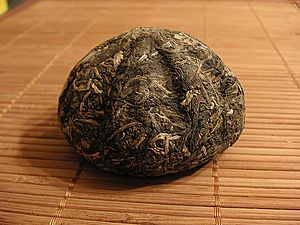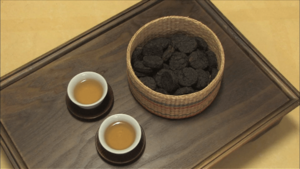Fermented tea facts for kids
Fermented tea (also known as post-fermented tea or dark tea) is a special kind of tea. Unlike other teas, it goes through a process called fermentation. This means tiny living things, like molds and bacteria, help change the tea leaves. This process can take anywhere from a few months to many years!
During fermentation, the tea leaves are exposed to moisture and air. This makes the leaves and the tea brewed from them turn darker. That's why these teas are often called "dark tea." The most famous dark tea is Pu'er, which comes from the Yunnan province in China.
The fermentation changes the tea's chemistry. This affects how the tea smells and tastes. It usually makes the tea smoother, less bitter, and more pleasant to drink. Sometimes, the tiny living things involved might even create good things for your health!
Most fermented teas come from China, where tea first started. But you can also find some types in Korea and Japan. In Myanmar, there's a fermented tea called lahpet that people actually eat like a vegetable! Similar pickled teas are also eaten or chewed in parts of Thailand and southern China.
Contents
A Look at History
The exact beginning of dark tea isn't fully clear. But there are some cool stories and ideas about how it started.
One popular legend says that dark tea was made by accident. Long ago, tea was carried by caravans along trade routes like the Silk Road. If it rained a lot, the tea would get wet and start to mold. The transporters sometimes left this "spoiled" tea behind. The story goes that later, people in nearby villages got sick. In desperation, they tried drinking the abandoned, moldy tea. The legend claims the tea made them better, and soon, it became very popular!
More historical records suggest that dark tea first became a thing during the Ming dynasty in China (around the 1400s and 1500s). It might have been traded by tea merchants even earlier than the legends say. This trade happened across the old borders between Chinese and Tibetan areas.
Types of Fermented Tea
Fermented teas can be grouped by how they are made.
Some teas, like many Chinese dark teas and Japan's Toyama kurocha, are fermented with natural fungi. This happens in fairly dry conditions. These are sometimes called "piled teas."
Other fermented teas are made using a wet process with special bacteria. These are called "pickled teas." Examples include miang from Thailand and awabancha from Japan.
There's also a third group, like Japan's goishicha. These teas use both methods: first, they are fermented with fungi, and then with bacteria.
China's Dark Teas
Fermented tea started in China. There, it's often called hei cha (which means "dark tea"). Hei cha is made in many parts of China, especially in the warmer southern provinces. It's often pressed into solid shapes like bricks or cakes. This makes it easier to store and age.
Here are some famous types and places where they are made:
- Anhui: Liu an lan cha (Anhui Lu'an basket tea)
- Guangxi: Liu bao cha (Guangxi Liubao tea)
- Hubei: Qing zhuan cha (Hubei green brick tea)
- Hunan: Fu zhuan cha (the famous fu zhuan "brick tea")
- Jingyang, Shaanxi: Fu zhuan cha (another famous fu zhuan "brick tea")
- Sichuan: Lu bian cha (Sichuan border tea)
- Tibet: Zang cha (Tibetan tea, often called Tibetan brick tea)
- Yunnan: Pu'er cha (either "raw" sheng pu'er or "ripened" shu pu'er)
Dark teas come in many shapes, including:
- Bamboo leaf logs
- Cakes, called bing cha
- Bricks, called zhuan cha
- Loose tea, often in baskets
- Bird nests, called tuo cha (usually Pu'er tea)
- Squares, called fang cha
Japanese Fermented Teas
Japan also makes several unique fermented teas. Toyama prefecture's kurocha is Japan's only "piled tea," similar to Chinese dark teas. People traditionally prepare it by boiling it with salt and stirring it. It's often enjoyed during religious events or meetings.
Awabancha from Tokushima Prefecture and batabatacha are made from bancha (second-harvest tea leaves). These teas use bacterial fermentation.
Goishicha from Ōtoyo, Kōchi and Ishizuchi kurocha from Ehime Prefecture are made using a two-step fermentation. First, they use fungi, and then bacteria.
Korean Fermented Teas
Tteokcha (meaning "cake tea") was the most common type of tea in Korea long ago. This pressed tea was sometimes shaped like old coins with holes in the middle. These were called doncha or jeoncha.
Borim-cha is a popular type of tteokcha. It's named after the Borim temple in Jangheung County, where it was first made.
Edible Pickled Tea
People have been chewing tea leaves for centuries, even though it's not common today.
In Northern Thailand, there's a pickled tea called miang that people chew as a stimulant. Steamed tea leaves are pressed into sealed bamboo baskets. They ferment there until they become a solid cake with a special flavor. This can take from four days to a year!
A pickled tea called lahpet is very popular in Burmese cuisine. It's also important in Burmese traditions. After it ferments, people eat it like a vegetable.
A similar pickled tea is eaten by the Blang people in Yunnan, China. This tea, called miam or suancha, is packed into bamboo tubes. Then, it's buried underground to ferment before it's eaten.
How Fermented Tea is Made
Many fermented teas aren't ready to drink right away when they are sold. They might start as green tea or partially oxidized teas. Then, they are allowed to slowly change and ferment over many years. This is a bit like how some wines are aged in a cellar.
Other fermented teas can be made quickly, in just a few months. This is done through a controlled process, similar to composting. The moisture and temperature of the tea are carefully watched. This creates "finished" fermented tea.
Fermented teas are often sold as compressed tea in different shapes. These can be bricks, discs, bowls, or even mushroom shapes. Ripened Pu'er teas are fermented when they are loose, and then pressed into shapes.
Fermented teas can be aged for many years to make their flavor even better. Raw Pu'er tea can be aged for up to 50 years without losing its quality! Ripened Pu'er can be aged for 10 to 15 years. Experts sometimes disagree on the perfect age for these teas.
Many people in Tibet and Central Asia use Pu'er or other fermented teas as a food source. They boil it with yak butter, sugar, and salt to make yak butter tea. This drink provides calories and important nutrients.
Ageing and Storage
Fermented tea often becomes more valuable as it gets older. Dark tea is usually aged in bamboo baskets, wrapped in bamboo leaves, or kept in its original packaging.
Many types of dark tea are aged in humid places on purpose. This helps certain fungi grow. These fungi are often called "golden flowers" because of their bright yellow color.



